Carrabungla (Symbol: Ca)
EG38 | EG87
Geology
Devonian rhyolites and rhyodacites (Wellington Rhyolites, Snowy River Volcanics).
Landform
In the context of this report the Carrabungla map unit encompasses steep hills at an elevation range of about 250 to 1,000 m and a relief range of 90 to 300 m. The slope gradients exceed 15% but are generally much steeper, commonly 30 to 80%.
At this stage, no separate components have been described for this map unit.
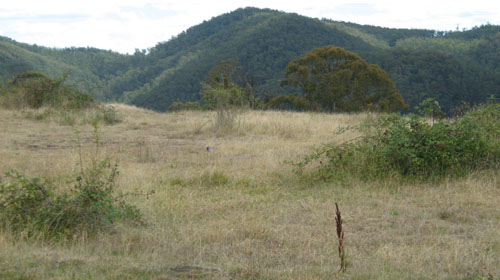
The steep hills of the Carrabungla Map Unit are in the background. In the foreground is dissected plateau mapped as the
W Tree Map Unit.
Native vegetation
Shrubby dry forest.
Soils
Most of the soils are believed to be shallow, reflecting the steep slopes and the resistance of the parent materials to weathering. Where deeper soils have developed, the pHs throughout the profile appear to be more acidic.
Land use
Except for areas on the fringe of the freehold land most of the area defined by this map unit remains uncleared.
Site EG38
| Location: Butchers Ridge | Geo. Ref. 611100E 5875600N |
| Australian soil classification: Bleached, Eutrophic, Yellow DERMOSOL (Stony) | Stony bleached yellow gradational soil |
| General landscape description: Steep hills | |
| Geology: Devonian Volcanics (Snowy River Volcanics) | |
| Site description: Road exposure on lower hill-slope, NNW aspect 42% slope, 40% rock outcrop | |
| Land use: Partially cleared | |
| Map unit: Carrabungla |
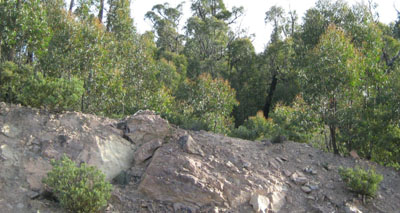
Road exposure near Seldom Seen, showing the rocky nature of the soils on the Carrabungla Map Unit.
Soil profile morphology
| Surface soil | 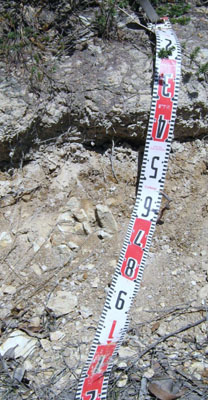 Soil profile typical of the Carrabungla Map Unit | ||
| A1 | 0 – 20 cm | Greyish brown; sandy loam; weak consistence moist; variable amounts of angular tabular rock mostly up to 200 mm; gradual change to: | |
| Subsoil | |||
| B1 | 20 – 40 cm | Pale brown; sandy clay loam; firm consistence moist; increasing amounts of angular tabular parent rock; gradual change to: | |
| B2 | 40 – 70 +cm | Light yellowish brown; light clay; firm consistence moist; abundant angular tabular stones passing to parent rock. | |
Key profile features
| |||
Soil profile characteristics
| pH | Salinity rating | Sodicity | Dispersion | Slaking | |
| Subsoil (B1 horizon) | Slightly acid | Very low | Non sodic | None | Slakes partially |
| Deeper subsoil (40-70 cm) | Slightly acid | Very low | Non sodic | None | Slakes partially |
| Horizon | Depth cm | Field texture | pH water | pH CaCl2 | EC dS/m | Coarse sand % | Fine sand % | Silt % | Clay % | Field cap. % w/w | Wilt. point % w/w | PAW* water % w/w |
| B1 | 20-40 | SCL | 6.3 | 5.6 | 0.05 | 34 | 29 | 19 | 18 | 24.2 | 7.2 | 17.0 |
| B2 | 40-70 | SLC | 6.3 | 5.6 | 0.05 | 28 | 24 | 14 | 33 | 25.4 | 10.2 | 15.2 |
| Depth | Org C# | Total N | Free Fe2O3 | Exch. Al | Exchangeable cations cmol(+)/kg | Ca:Mg | ESP | ||||||
| cm | % | % | % w/w | ppm | Ca | Mg | K | Na | Total | H | CEC | ||
| 20-40 | <1 | 4.3 | 1.1 | 0.27 | 0.06 | 5.8 | 5.1 | 10.9 | 3.9 | <1 | |||
| 40-70 | <1 | 4.5 | 2.1 | 0.43 | 0.1 | 7.2 | 6.1 | 13.3 | 2.2 | <1 | |||
Management considerations
Whole profile
- The profile is slightly acid throughout.
- If the soil was under pasture with an effective rooting depth of 70 cm the plant available water capacity is considered to be low; estimated at 47 mm due to its stony nature.
Although no surface sample was taken, it would be safe to assume:
- The low wilting point of the sub-surface horizon indicates if pasture species are grown, they will be able to use light rains when the soil is dry. Due to the low water storage capacity of the soil, plants will suffer water stress unless further rains occur.
- The soils are slightly acidic and, under pasture, would show little if any response to lime.
- The nutrient holding capacity of the soil is very low, based on the sum of the exchangeable basic cations.
- Potassium levels are deficient and a response to potassium fertilisers would be expected if the soils were under pasture.
| Location: Seldom Seen | Geo. Ref. 610500E 5890700N |
| Australian soil classification: Bleached, Dystrophic, Grey KANDOSOL | |
| General landscape description: Steep hills | |
| Geology: Devonian Volcanics (Snowy River Volcanics) | |
| Site description: Upper slope, NE aspect, 21 % slope | |
| Land use: Native forest | |
| Map unit: Carrabungla |
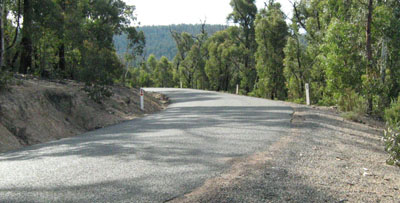
Soil profile morphology
| Surface soil | 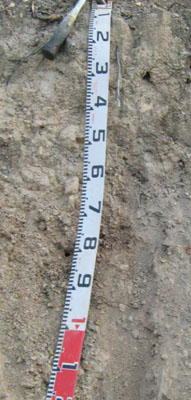 | ||
| A1 | 0 – 5 cm | Grey (7.5YR6/1); silty loam; weak subangular blocky structure, weak consistence dry; few (2 – 10%) subangular gravel (6 – 6 mm) fragments; clear change to: | |
| A21 | 5 – 20 cm | Pinkish grey (7.5YR7/2;) conspicuously bleached (5YR8/1d) silty loam; massive, firm consistence moderately moist; few (2 – 10%) subangular gravel (2 – 6 mm) fragments; gradual change to: | |
| A22 | 20 – 45cm | Pinkish grey (7.5YR7/2); silty loam; massive structure, firm consistence moderately moist; few (2 – 10%) subangular gravel (2 – 6 mm) fragments; clear change to: | |
| Subsoil | |||
| B2 | 45 – 75+ cm | Mottled pinkish grey (7.5YR7/3) and pinkish white (7.5YR7/3) silty clay loam; weak coarse prismatic structure, firm consistence moderately moist common (10 – 20%) subangular gravel (2 – 6mm) fragments |
Key profile features
- Lack of strong texture contrast between the surface soils (A1, A21 and A22) horizons and the subsoil (B) horizon.
| pH | Salinity rating | Sodicity | Dispersion | Slaking | |
| Surface soil (A1 horizon) | Strongly acid | Very low | Non sodic | None1 | Slakes partially |
| Subsoil (B2 horizon) | Strongly acid | Very low | Non sodic | None | Slakes partially |
| Horizon | Depth cm | Field texture | pH water | pH CaCl2 | EC dS/m | Coarse sand % | Fine sand % | Silt % | Clay % | Field cap. % w/w | Wilt. point % w/w | PAW* water % w/w |
| A21 | 5-20 | ZL | 5.1 | 4.7 | <0.05 | 16 | 22 | 43 | 18 | 25.8 | 8.3 | 17.5 |
| A22 | 20-45 | ZL | 4.9 | 4.5 | <0.05 | 19 | 23 | 44 | 12 | 27.6 | 6.0 | 21.6 |
| B2 | 45-75 | ZCL | 5.4 | 4.5 | <0.05 | 20 | 23 | 37 | 20 | 25.8 | 10.5 | 15.3 |
| Depth | OrgC# | Total N | Free Fe2O3 | Exch. Al | Exchangeable cations cmol(+)/kg | Ca:Mg | ESP | ||||||
| cm | % | % | % w/w | ppm | Ca | Mg | K | Na | Total | H | CEC | ||
| 5-20 | 3.5 | 0.11 | 330 | 0.37 | 0.67 | 0.28 | 0.08 | 1.4 | 7.4 | 8.4 | 0.6 | 1 | |
| 20-45 | 320 | 0.49 | 0.35 | 0.27 | 0.10 | 1.3 | 9.3 | 10.6 | 1.4 | 1 | |||
| 45-75 | 270 | 0.13 | 0.9 | 0.32 | 0.11 | 1.5 | 6.2 | 7.7 | 0.2 | 1 | |||
Management considerations
Whole profile
- The profile is strongly acid throughout.
- The level of exchangeable aluminium measured for this site is quite high (330 ppm). The growth of aluminium sensitive species, such as lucerne, may be restricted. Aluminium and manganese toxicity may occur.
- There should be likely long term benefits of applying lime, preferably incorporated, on this site if the test results are representative of the paddock. A pH/aluminium test is, however, best performed from samples taken across the paddock and bulked together.
- Before lime is recommended other factors need to be considered including pasture species grown, method of application, local trial responses, soil surface structure and likely cost/benefit.
- If the soil was under pasture with an effective rooting depth of 75 cm the plant available water capacity is considered to be low; estimated at 54 mm.
- The soil has a reasonable organic matter content.
- The low wilting point of the surface horizons indicates if pasture species are grown, they will be able to use light rains when the soil is dry. Due to the low water storage capacity of the soil, plants will suffer water stress unless further rains occur.
- The soils are strongly acidic and, if under pasture, would show a marked response to lime.
- The nutrient holding capacity of the soil is very low (based on the sum of the exchangeable basic cations).
- Potassium levels are deficient and a response to potassium fertilisers would be expected if the soils were under pasture.


